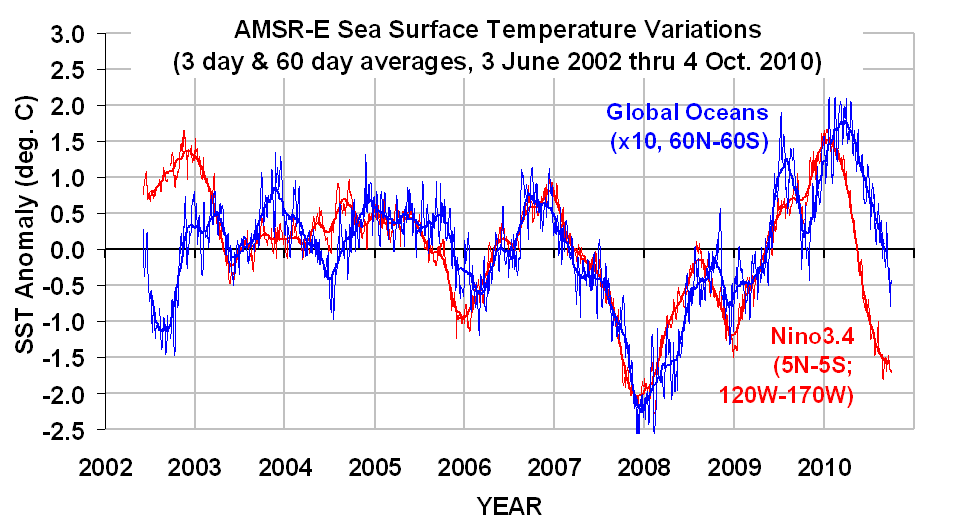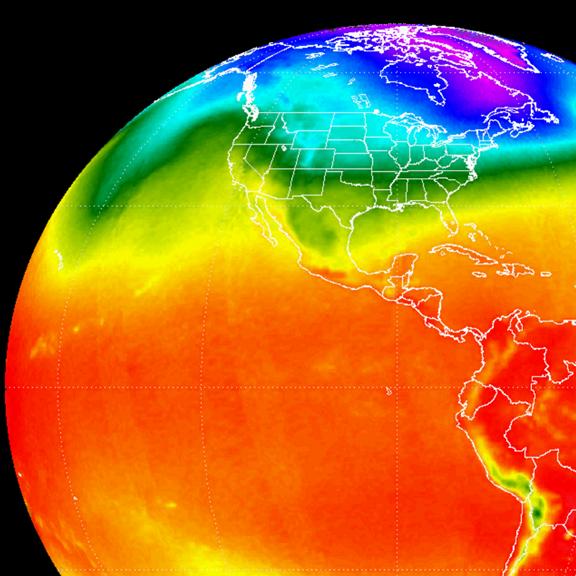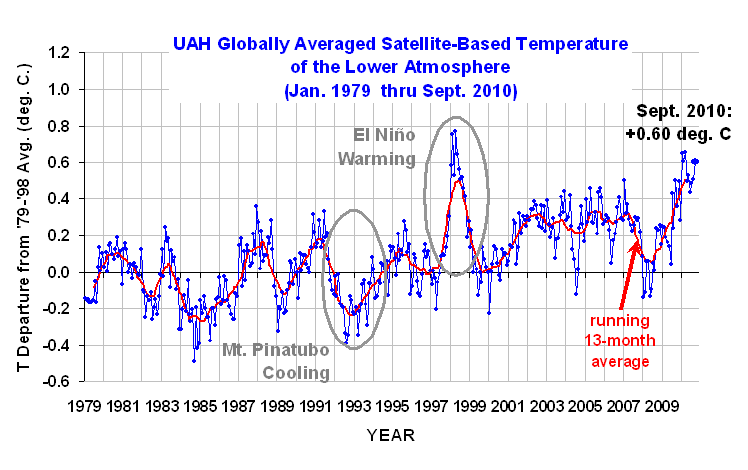(edited for clarity at 2:45 p.m.)
There was a very clever paper published in Science this past week by Lacis, Schmidt, Rind, and Ruedy that uses the GISS climate model (ModelE) in an attempt to prove that carbon dioxide is the main driver of the climate system.
This paper admits that its goal is to counter the oft-quoted claim that water vapor is the main greenhouse gas in our atmosphere. (They provide a 1991 Lindzen reference as an example of that claim).
Through a series of computations and arguments, the authors claim that is actually the CO2, not water vapor, that sustains the warmth of our climate system.
I suspect this paper will result in as many opinions in the skeptic community as there are skeptics giving opinions. But unless one is very careful in reading this paper and knows exactly what the authors are talking about, it is easy to get distracted by superfluous details and miss the main point.
For instance, their table comparing the atmospheres of the Earth, Venus, and Mars does nothing to refute the importance of water vapor to the Earth’s average temperature. While they show that the atmosphere of Mars is very thin, they fail to point out the Martian atmosphere actually has more CO2 than our atmosphere does.
I do not have a problem with the authors’ calculations or their climate model experiment per se. There is not much new here, and their model run produces about what I would expect. It is an interesting exercise that has value by itself.
It is instead their line of reasoning I object to — what they claim their model results mean in terms of causation– in their obvious attempt to relegate the role of water vapor in the atmosphere to that of a passive component that merely responds to the warming effect of CO2…the real driver (they claim) of the climate system.
OUR ASSUMPTIONS DETERMINE OUR CONCLUSIONS
From what I can tell reading the paper, their claim is that, since our primary greenhouse gas water vapor (and clouds, which constitute a portion of the greenhouse effect) respond quickly to temperature change, vapor and clouds should only be considered “feedbacks” upon temperature change — not “forcings” that cause the average surface temperature of the atmosphere to be what it is in the first place.
Though not obvious, this claim is central to the tenet of the paper, and is an example of the cause-versus-effect issue I repeatedly refer to in the past when discussing some of the most fundamental errors made in the scientific ‘consensus’ on climate change.
It is a subtle attempt to remove water vapor from the discussion of “control” over the climate system — by definition. Only those of us who know enough of the details of forcing-feedback theory within the context of climate change theory will likely realize this, through.
Just because water vapor responds quickly to temperature change does not mean that there are no long-term water vapor changes (or cloud changes) — not due to temperature — that cause climate change. Asserting so is a non sequitur, and just leads to circular reasoning.
I am not claiming the authors are being deceptive. I think I understand why so many scientists go down this path of reasoning. They view the climate system as a self-contained, self-controlled complex of physically intertwined processes that would forever remain unchanged until some “external” influence (forcing) enters the picture and alters the rules by which the climate system operates.
Of course, increasing CO2 is the currently fashionable forcing in this climatological worldview.
But I cannot overemphasize the central important of this paradigm (or construct) of climate change theory to the eventual conclusions the climate researcher will inevitably make.
If one assumes from the outset that the climate system can only vary through changes imposed external to the normal operation of the climate system, one then removes natural, internal climate cycles from the list of potential causes of global warming. And natural changes in water vapor (or more likely, clouds) are one potential source of internally-driven change. There are influences on cloud and water vapor other than temperature which in turn help to determine the average temperature state of the climate system.
After assuming clouds and water vapor are no more than feedbacks upon temperature, the Lacis et al. paper then uses a climate model experiment to ‘prove’ their paradigm that CO2 drives climate — by forcing the model with a CO2 change, resulting in a large temperature response!
Well, DUH. If they had forced the model with a water vapor change, it would have done the same thing. Or a cloud change. But they had already assumed water vapor and clouds cannot be climate drivers.
Specifically, they ran a climate model experiment in which they instantaneously removed all of the atmospheric greenhouse gases except water vapor, and they got rapid cooling “plunging the climate into an icebound Earth state”. The result after 7 years of model integration time is shown in the next image.
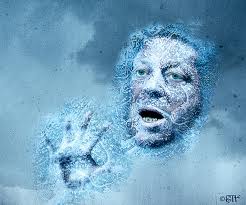
Such a result is not unexpected for the GISS model. But while this is indeed an interesting theoretical exercise, we must be very careful about what we deduce from it about the central question we are ultimately interested in: “How much will the climate system warm from humanity adding carbon dioxide to it?” We can’t lose sight of why we are discussing all of this in the first place.
As I have already pointed out, the authors have predetermined what they would find. They assert water vapor (as well as cloud cover) is a passive follower of a climate system driven by CO2. They run a model experiment that then “proves” what they already assumed at the outset.
But we also need to recognize that their experiment is misleading in other ways, too.
First, the instantaneous removal of 100% of the greenhouse gases in the atmosphere except for water vapor causes about 8 times the radiative forcing (over 30 Watts per sq. meter) as does a 100% increase in CO2 (2XCO2, causing less than 4 Watts per sq. meter), something that will not occur until late this century — if ever.
This is the so-called ‘logarithmic effect’…adding more and more CO2 has a progressively weaker radiative forcing response.
Currently, we are about 40% of the way to that doubling. Thus, their experiment involves 20 times (!) the radiative forcing we are now experiencing (theoretically, at least) from over a century of carbon dioxide emissions.
So are we to assume that this dramatic theoretical example should influence our views of the causes and future path of global warming, when their no-CO2 experiment involves ~20 times the radiative forcing of what has occurred to date from adding more CO2 to the atmosphere?
Furthermore, the cloud feedbacks in their climate model are positive, which further amplifies the model’s temperature response to forcing. As readers here are aware, our research suggests that cloud feedbacks in the real climate system might be so strongly negative that they could more than negate any positive water vapor feedback.
In fact, this is where the authors have made a logical stumble. Everyone agrees that the net effect of clouds is to cool the climate system on average. But the climate models suggest that the cloud feedback response to the addition of CO2 to our current climate system will be just the opposite, with cloud changes acting to amplify the warming.
What the authors didn’t realize is that when they decided to relegate the role of clouds in the average state of the climate system to one of “feedback”, their model’s positive cloud feedback actually contradicts the known negative “feedback” effect of clouds on the climate’s normal state.
Oops.
(In retrospect, I suppose they could claim that cloud feedbacks switched from negative at the low temperatures of an icebound Earth, to being positive at the higher temperatures of the real climate system. But that might mess up Jim Hansen’s claim of strongly positive feedbacks during the Ice Ages).
CONCLUSION
Taken together, the series of computations and claims made by Lacis et al. might lead the casual reader to think, “Wow, carbon dioxide really does have a strong effect on the Earth’s climate system!” And, in my view, it does. But the paper really tells us nothing new about (1) how much warming we can expect from adding more CO2 to the atmosphere, or (2) how much of recent warming was caused by CO2.
The paper implies that it presents new understanding, but all it does is get more explicit about the conceptual hoops one must jump through in order to claim that CO2 is the main driver of the climate system. From that standpoint alone, I find the paper quite revealing.
Unfortunately, what I present here is just a blog posting. It would take another peer-reviewed paper that follows an alternative path, to effectively counter the Lacis paper, and show that it merely concludes what it assumes at the outset. I am only outlining here what I see as the main issues.
Of course, the chance of editors at Science allowing such a response paper to get published is virtually zero. The editors at Science choose which scientists will be asked to provide peer review, and they already know who they can count on to reject a skeptic’s paper.
Many of us have already been there, done that.
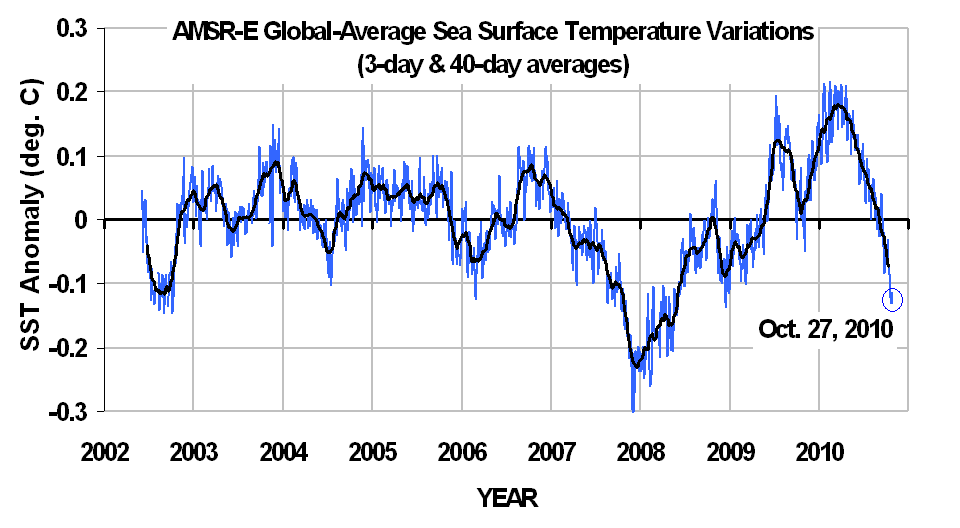


 Home/Blog
Home/Blog
